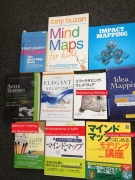I was recently introduced to Gojko Adzic’s “Impact Mapping” by Tom Poppendieck during Agile India 2013, and impressed by the business goal capturing method as well as how he used mindmapping technique in his method. I myself have been using Mindmapping for a long time, and also published a book “Mindmapping in Agile software development” and an article “Exploring User Wish Through Mindmapping” about mindmapping in software development related area.
So I did a small research on how mind mapping and its variants are utilized in my area(software development, testing, lean thinking, lean startup, design thinking) as far as I know. Here’s the list.
- General Mind Mapping
- “The Mind Map Book” by Tony Buzan is the bible, also try my favorite ”Mind Maps for Kids“.
- “Pragmatic Thinking and Learning: Refactoring Wetware” by Andy Hunt, Section 5.8 “Visualize Insight with Mind Maps” introduces mindmapping.
- Idea Map … “Idea Mapping” by Jamie Nast. Mindmapping with more flexible rules.
- Mindmapping in Software Development
- “Mindmapping in Agile software developement“(『ソフトウェア開発に役立つマインドマップ』) by me
Covers a lot of visualization ideas you can use in your software development team. - “Mind Map Modeling“(『マインドマップではじめるモデリング講座』) by Tomoharu Asami
Introduces an interesting idea of using mind mapping for domain modeling before it is formally modeled in UML. - “Agile and Iterative Development” by Craig Larman
mentions “mind maps” and “affinity clustering” as practice tips in Chatper 11.
- “Mindmapping in Agile software developement“(『ソフトウェア開発に役立つマインドマップ』) by me
- Lean(TPS)
- A3 thinking(Lean) … ”Understanding A3 thinking” by Durward K. Sobek and see also a template by Henrik Kniberg
- Think in Pictures … “The Elegant Solution” by Mathew May, Chapter 7 “Think in Pictures” covers how Toyota uses pictures to share the product concepts.
- Testing
- “Agile Testing” by Lisa Crispin + Janet Gregory uses mind maps for chapter structuring to guide the readers.
- “Mind Maps As Part Of The Agile Testing Process“ by Martin Mussmann
Using Mind maps for designing, visualizing the tests and the strategies. I recently found this during the research. - “Software Testing with Mind Maps“( 『マインドマップからはじめる ソフトウェアテスト』) by Akira Ikeda and Mikio Suzuki
Thorough description of software testing process with rich examples of mind maps.
- (Lean) Business and User Experience
- “Impact Mapping” by Gojko Adzic
A strategic planning technique for clearly communicating overall business objectives and for making better roadmap decisions. - “User Story Mapping” by Jeff Patton
Big picture of a product vision, with epics, stories, hierachically mapped user stories. - “Affinity Diagram” in Design Thinking … I found this in IDEO method cards, but searching for the source, and it comes from Six Sigma tool kit ?!
- “Impact Mapping” by Gojko Adzic
Some of the above are written only in Japanese, but they are rich in contents compared to others. Hope they are translated into English soon.
Also note that non-radiant structure mapping like “User Story Mapping” by Jeff Patton are included in the above. I guess I need more analysis of categorization, and I also have to add other non-radiant structure like matrix/tabular form in this map, including:
- “Business Model Canvas” described in “Business Model Generation“(and “Business Model Ontology“) by Alexander Osterwalder et, al.
- “Lean Canvas” described in “Running Lean” by Ash Maurya
And here’s the map. (click to magnify or PDF)













































































